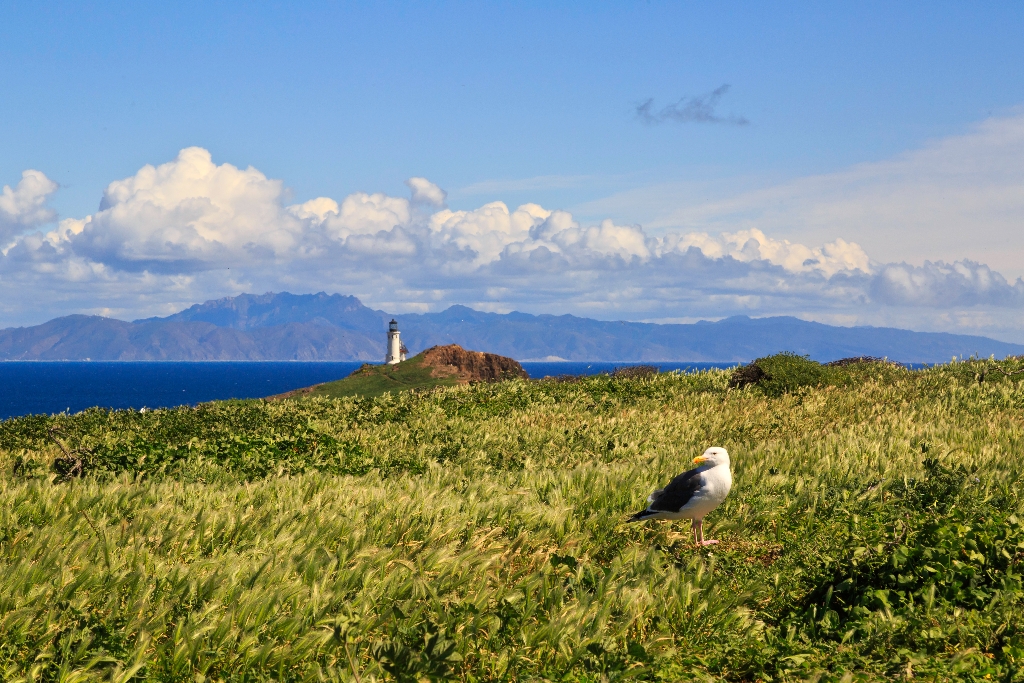
Flocks of sheep grazed Anacapa's grassy terraces from 1869 until the 1930s. On East Anacapa sheep ranching ended in 1912 when the first light beacon was constructed. In 1917 as many as five hundred sheep ran on Anacapa.
Sheep ranchers found that Anacapa's isolation offered several advantages. Unlike their mainland counterparts, the flocks were safe from coyotes and wild dogs. They also could be left to wander freely with no need for fences.
But isolation created disadvantages as well. Shearers had to be transported by boat to the island, and seafaring poachers were constant nuisances. With no natural source of fresh water except early morning dew, the animals licked
moisture from each other's coats and the vegetation. The sheep devoured the native vegetation. When forage was especially scarce the sheep had to be removed from the island by boat.
Sheep ranching on Anacapa ended in 1938 when the islets came under the jurisdiction of the National Park Service. Today the widespread presence of introduced grasses such as wild oats, foxtails, and brome are evidence of this period in Anacapa's history.
More Sheep Ranching History
Around 1885, E. E. Elliot had a sheep camp on Anacapa Island around as evidenced by photographs in the Santa Barbara Historical Society collection. Elliot constructed a number of buildings on the middle island that became known as "The Houses" and planted eucalyptus trees that remain. He eventually abandoned his operation due to problems with poaching by fishermen. Elliot apparently had no government lease.
The earliest lease recorded in lighthouse files was that awarded to Louis le Mesagner by the Department of Treasury for $25 a year beginning April 1, 1902. Charles Holder, who visited the islands at about this time, called it a sheep ranch and reported that several hundred animals found sustenance there even in the summer. A herder volunteered that although there was no water, there was an abundance of fog. The moisture from this was soaked up by the sheep's coats and in the morning they licked each other to obtain water, a somewhat dubious story heard on other islands as well. In the spring, Indians and Mexicans were hired by the sheep owners to go to the island and shear the sheep.
The Department of Commerce and Labor leased Anacapa Island to former island seal hunter and long-time Ventura resident Heaman Bayfield Webster on April 1, 1907, for $31 a year. The lease read "All the Island of Anacapa . . . consisting of three islets . . . and known as the Anacapa Light Reservation . . . for grazing and farming only." He could place on it no permanent buildings, and the lease noted that previous sheepherders had left an old cistern. Webster's sheep herd increased to about 600 through breeding but depredations by fishermen, eagles and drought resulted in continuous losses.
Webster established residence on the middle island with his wife Martha and two sons, Morris and Harvey. They built or reused five shacks to each of which they affixed a name: Camp Felicity, Camp Simplicity, Camp Capacity, Camp Intensity and Camp Necessity, the latter being an outhouse with a toilet flushed by sand. Camps Felicity and Simplicity had roofs, floors and furnishings while the others were less substantial. The location was apparently the one occupied by Elliot in the 1880s, marked by eucalyptus trees.
Webster constructed a water storage tank, which he kept filled with water imported from the mainland in five-gallon cans. The family spent summers and two winters on the island tending the flock of sheep, and a caretaker stayed during the Websters' absences. The Websters welcomed vacationers who arrived in their own boats or on one of Bay Webster's charters. Early on the newspapers referred to him as the "King of Anacapa Island." In the fall of 1911 Webster set up a school in a tent for his children, and hired a governess for them. "He is pretty sure that he is the first man to ring a school bell on the island," wrote a reporter, "which he calls a strip of rock six miles long and something over an inch wide."
Webster obtained his income from tourism and wool sales. He sold no more than 50 sheep during the ten years on the island but concentrated on breeding and shearing. He herded the sheep from the west island towards the east where they were sheared, either hog-tying them for the inter-island trip in a boat or forcing them to swim the distance.
Various lessees continued to ranch on the island after Webster. However, by the 1930s the sheep had destroyed most of the native plants useful to them and had begun to eat the endemic Astragalus miguelensis. From this many sheep died, taking the profit out of sheep herding and bringing to an end to sheep ranching when Anacapa became part of Channel Islands National Monument in 1938.
Is there something we missed for this itinerary?
Itineraries across USA


















































